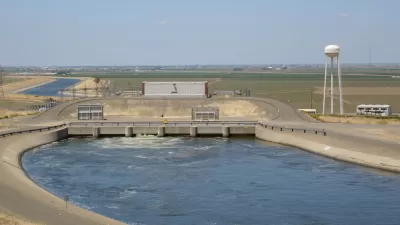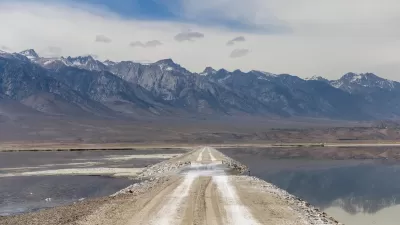The controversial construction of the Los Angeles Aqueduct provided grist for famous books and movies, and conflicts that continue to this day. In a multimedia feature, Louis Sahagun explores the history of the project that helped birth modern L.A.
One hundred years ago this Saturday, water poured forth from the mouth of the Los Angeles Aqueduct into the L.A. basin for the first time after a 200-mile trip from the Owens Valley. "The job — completed on time and under budget — required 215 miles of road, 280 miles of pipeline, 142 tunnels, more than 1 million barrels of cement and 6 million pounds of dynamite," writes Sahagun.
"The Los Angeles Aqueduct — powered by gravity alone as it tapped the snows of the Sierra Nevada more than 200 miles to the north — ensured reliable irrigation for farms and ranches and nurtured a galaxy of prosperous Southern California suburbs and industrial centers," he adds. "Like a magnet, it pulled in millions of people from around the country, offering them new jobs, communities and lifestyles."
“It will continue to serve the city for another 100 years,” said DWP water systems manager Marty Adams, “and, with maintenance, a lot longer than that.”
FULL STORY: ‘THERE IT IS — TAKE IT’ A century of marvel and controversy

Study: Maui’s Plan to Convert Vacation Rentals to Long-Term Housing Could Cause Nearly $1 Billion Economic Loss
The plan would reduce visitor accommodation by 25,% resulting in 1,900 jobs lost.

North Texas Transit Leaders Tout Benefits of TOD for Growing Region
At a summit focused on transit-oriented development, policymakers discussed how North Texas’ expanded light rail system can serve as a tool for economic growth.

Why Should We Subsidize Public Transportation?
Many public transit agencies face financial stress due to rising costs, declining fare revenue, and declining subsidies. Transit advocates must provide a strong business case for increasing public transit funding.

How to Make US Trains Faster
Changes to boarding platforms and a switch to electric trains could improve U.S. passenger rail service without the added cost of high-speed rail.

Columbia’s Revitalized ‘Loop’ Is a Hub for Local Entrepreneurs
A focus on small businesses is helping a commercial corridor in Columbia, Missouri thrive.

Invasive Insect Threatens Minnesota’s Ash Forests
The Emerald Ash Borer is a rapidly spreading invasive pest threatening Minnesota’s ash trees, and homeowners are encouraged to plant diverse replacement species, avoid moving ash firewood, and monitor for signs of infestation.
Urban Design for Planners 1: Software Tools
This six-course series explores essential urban design concepts using open source software and equips planners with the tools they need to participate fully in the urban design process.
Planning for Universal Design
Learn the tools for implementing Universal Design in planning regulations.
City of Santa Clarita
Ascent Environmental
Institute for Housing and Urban Development Studies (IHS)
City of Grandview
Harvard GSD Executive Education
Toledo-Lucas County Plan Commissions
Salt Lake City
NYU Wagner Graduate School of Public Service




























